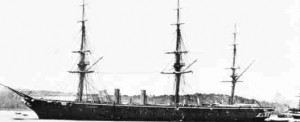- Author
- Bastock, John
- Subjects
- None noted
- Tags
-
- RAN Ships
- None noted.
- Publication
- December 1971 edition of the Naval Historical Review (all rights reserved)
Introduction:
Britain’s first sea-going ironclad, HMS Warrior, took the water in December 1860. For nearly one hundred years afterwards, Warrior’s successors dominated the naval scene, and the battleships of Britain became symbols of the mighty Empire whose covenants they were pledged to uphold.
Now, of course, they are but a memory; they have passed into history, having been displaced in the naval scheme of things by the aircraft carrier and the missile-firing submarine.
From the Warrior of 1860 to the Vanguard of 1946, Britain possessed some 160 vessels which might be classed as battleships (as distinct from battle-cruisers). The following notes and photographs have been assembled to illustrate some of the highlights in the various stages of their development.
WARRIOR
Launched: 1860
Displacement: 9,210 tons
Length: 418 feet
Beam: 58 feet
Armament: (as completed)

Twenty-six 68- pounder smooth-bore muzzle-loaders. Ten 110-pounder smooth-bore breech-loaders. Four 20-pounder smooth-bore breech- loaders.
She was ship-rigged, and the funnels could be lowered to minimise obstruction to sailing operations when making a passage under sail only. Most of the heavy guns were carried on the broadside, firing through square ports within the armoured section of the ship.
In 1867, she was re-armed with 7-in. and 8-in. rifled muzzle-loaders, retaining the four 20-pounder breech-loaders for saluting purposes.
Protection: (Sides), 4½ inches of iron backed by 18 inches of teak.
Machinery: IHP 5,270. Single screw. Speed under steam, 14 knots.
Warrior, the first British sea-going armoured battleship, was built to meet the challenge of the French wooden ship Gloire, which had been armoured with iron plates.
Built entirely of iron, Warrior spelt the doom of the old ‘wooden walls’. Most of her seagoing service was spent in British home waters. She had the distinction of being not only the first, but also the last British armoured battleship afloat, as, up to the mid- 1960s, she was still in use, as an oil pipeline jetty at Pembroke.




